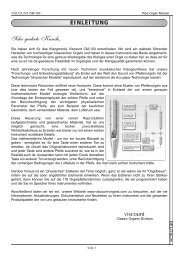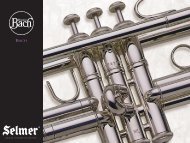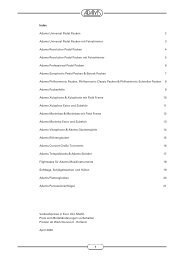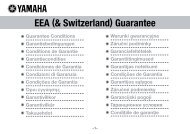CM100 Advanced Manual (GB).pdf (1.347,89kb) - Viscount ...
CM100 Advanced Manual (GB).pdf (1.347,89kb) - Viscount ...
CM100 Advanced Manual (GB).pdf (1.347,89kb) - Viscount ...
Create successful ePaper yourself
Turn your PDF publications into a flip-book with our unique Google optimized e-Paper software.
VISCOUNT CM-100<br />
Pipe Organ Module<br />
The procedure for modifying these parameters is easy and intuitive:<br />
Use the cursor ,, , keys to locate on the value of the parameter you wish to modify (the field will<br />
start to flash), then turn the encoder to enter the value you require.<br />
Remember that turning the encoder clockwise increases the value, while turning it anticlockwise<br />
decreases the value.<br />
The instrument will adopt the value entered and automatically save it in the current finish.<br />
<br />
A BRIEF NOTE ON TEMPERAMENTS <br />
In the "natural" tuning system, based on the acoustic phenomenon of harmonic sounds, two important musical<br />
intervals, the major third and the perfect fifth, cannot be made to coexist in the "pure" state (i.e. beat-free).<br />
Therefore, over the centuries a variety of compromise solutions known as TEMPERAMENTS have been<br />
invented and realised. These give priority to one or the other interval by modifying them in various ways.<br />
In the ancient world and the Middle Ages, until the last few decades of the 17th Century, the "Pythagorean"<br />
tuning system, in which the fifths were retained perfectly pure, was in use. The resulting major third was<br />
particularly unattractive in sound, and was therefore treated as a dissonance. However, the music of the time<br />
was mainly monodic, and the early forms of vocal and instrumental polyphony made a great deal of use of the<br />
interval of a fifth. With the early Renaissance, and the start of the great flowering of vocal polyphony, the<br />
interval of a major third gradually came to be heard as consonant and not dissonant. The instruments with fixed<br />
tuning, such as the organ and harpsichord, gradually adapted to this situation by adopting a system of<br />
temperament known as "Meantone", which gave the major third priority over the fifth. This temperament is<br />
particularly important because it was the temperament in normal use in Europe in the 16th and 17th Centuries,<br />
until the early 18th Century. Here are the six temperaments available on the CM-100<br />
WERCKMEISTER: This temperament, invented by the organist and musical theorist Andreas Werckmeister, is<br />
recommended for performing the German musical repertoire of the late 1600s<br />
KIRNBERGER:This temperament, developed by Johann Philipp Kirnberger, pupil of J.S. Bach, is suitable for<br />
playing the German Baroque composers and the works of Bach.<br />
KELLNER:Herbert Anton Kellner, born in Prague in 1938, studied physics, mathematics and astronomy at the<br />
University of Vienna. In 1975, his research enabled him to identify the unequal temperament of the same name,<br />
used by Bach for his "Well-Tempered Clavier". Suitable for 18th Century German music and the music of Bach<br />
in particular.<br />
VALLOTTI: This Italian temperament invented by Francescantonio Vallotti was later taken up in England by<br />
Thomas Young. It can be used effectively for the Italian 18th Century repertoire, and also for the English<br />
repertoire of the same period.<br />
CHAUMONT (1696) :It is based on six pure major thirds: D-F# / E-G# / F-A / G-B / A-C# / C-E (the last one<br />
slightly diminished). It can be used mainly for French music composed between the end of the 17th and the<br />
beginning of the 18th Century.<br />
MEANTONE:<br />
- 8 pure major thirds: E flat - G / B flat - D / F - A / C - E / G - B / D - F # / A - C# / E - G.<br />
- 4 unusable major thirds (diminished fourths): B - D# / F# - A# / C# - E# / A flat - C.<br />
- 1 fifth known as the "wolf" (very dissonant extended fifth): A flat - E flat.<br />
- Highly irregular chromatic scale (meaning that chromatic compositions are given a very distinctive voice)<br />
- Keys usable with this temperament: C maj. / D maj. / G maj. / A maj. / B flat maj. and the relative minors.<br />
ENGLISH<br />
PYTHAGOREAN: In this temperament, all the fifths are natural except for the "wolf" fifth, in the interval A flat<br />
- E flat, which is greatly diminished.<br />
It dates from the Middle Ages up to the 15th century, and can therefore be used for compositions of that<br />
period.<br />
Page 10










